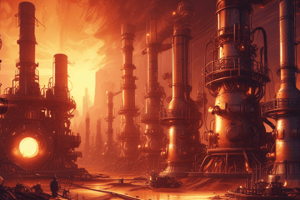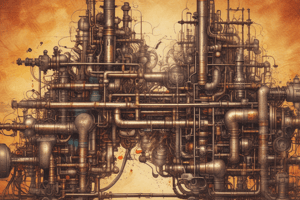Podcast
Questions and Answers
What is the primary chemical reaction that occurs when fire takes place?
What is the primary chemical reaction that occurs when fire takes place?
- Oxidation/Reduction (correct)
- Hydrolysis
- Synthesis
- Decomposition
What is the primary composition of wood, which is involved in the fire combustion process?
What is the primary composition of wood, which is involved in the fire combustion process?
- Hydrogen and oxygen molecules
- Nitrogen and carbon molecules
- Hydrogen and carbon molecules (correct)
- Carbon and oxygen molecules
What is the byproduct of wood combustion, which is released into the atmosphere?
What is the byproduct of wood combustion, which is released into the atmosphere?
- Oxygen and nitrogen
- Carbon dioxide and hydrogen gases (correct)
- Carbon dioxide and oxygen
- Nitrogen and helium
What is the term used to describe the most effective fuels or reducing agents?
What is the term used to describe the most effective fuels or reducing agents?
What is the minimum oxygen supply required for combustion to occur?
What is the minimum oxygen supply required for combustion to occur?
What type of ignition occurs when fuel combines with oxygen and an external heat source, producing smoke and heat?
What type of ignition occurs when fuel combines with oxygen and an external heat source, producing smoke and heat?
What is the primary cause of a backdraft in a fire?
What is the primary cause of a backdraft in a fire?
Which of the following is NOT a fire hazard?
Which of the following is NOT a fire hazard?
What is the result of removing a fire hazard from a potential fire situation?
What is the result of removing a fire hazard from a potential fire situation?
Which of the following is an example of a fire hazard that increases the severity of a fire?
Which of the following is an example of a fire hazard that increases the severity of a fire?
What is the purpose of a home fire inspection?
What is the purpose of a home fire inspection?
What is the phrase that summarizes the importance of watching smokers?
What is the phrase that summarizes the importance of watching smokers?
What is the primary purpose of drying the tip of the candle with a tissue?
What is the primary purpose of drying the tip of the candle with a tissue?
What is the expected outcome when trying to light the bottom of the candle?
What is the expected outcome when trying to light the bottom of the candle?
What is the primary focus of the fire preparedness plan?
What is the primary focus of the fire preparedness plan?
What is the first step to take in a fire emergency?
What is the first step to take in a fire emergency?
What is a characteristic of an excellent fire preparedness plan?
What is a characteristic of an excellent fire preparedness plan?
What is the purpose of the rubrics/scoring guide in the experiment?
What is the purpose of the rubrics/scoring guide in the experiment?
When is it likely to successfully extinguish a fire?
When is it likely to successfully extinguish a fire?
What is the expected outcome of revising the fire preparedness plan?
What is the expected outcome of revising the fire preparedness plan?
What should you consider before attempting to put out a fire on your own?
What should you consider before attempting to put out a fire on your own?
What is the fourth phase of a fire drill?
What is the fourth phase of a fire drill?
What should you prioritize if you are at risk of being suffocated by smoke?
What should you prioritize if you are at risk of being suffocated by smoke?
What is the ultimate decision maker in determining whether to try to put out a fire on your own?
What is the ultimate decision maker in determining whether to try to put out a fire on your own?
What is the purpose of Phase 5 in a drill?
What is the purpose of Phase 5 in a drill?
What is the primary purpose of conducting an evaluation in Phase 6?
What is the primary purpose of conducting an evaluation in Phase 6?
What is the Fire Tetrahedron Experiment designed to demonstrate?
What is the Fire Tetrahedron Experiment designed to demonstrate?
What is the purpose of soaking the tip of the candle in water in the Fire Tetrahedron Experiment?
What is the purpose of soaking the tip of the candle in water in the Fire Tetrahedron Experiment?
What is the primary focus of the books 'Disaster Readiness and Risk Reduction' by Aurelio et al. and Rimando?
What is the primary focus of the books 'Disaster Readiness and Risk Reduction' by Aurelio et al. and Rimando?
What is the purpose of taking pictures or documenting every step of the Fire Tetrahedron Experiment?
What is the purpose of taking pictures or documenting every step of the Fire Tetrahedron Experiment?
Flashcards are hidden until you start studying
Study Notes
Fire and Combustion
- Fire occurs when an oxidation/reduction reaction takes place, where a fuel (e.g. wood) is "reduced" in form in the presence of an oxidizing agent (oxygen) and changes chemical make-up.
- Heat and flames cause the wood to decompose, releasing energy in the form of heat and flame, and turning into ash (primarily carbon molecules).
- Products with high carbon and hydrogen content are effective fuels or "reducing agents".
- Examples of complex hydrocarbons include gasoline, propane, butane, and natural gas.
Stages of Fire Ignition
- The first stage of fire ignition involves the combination of heat, oxygen, and fuel source, resulting in a chemical reaction (fire tetrahedron).
- There are two types of ignition: auto ignition (combustion by heat without spark or flame) and piloted ignition (fuel + oxygen + external heat source).
- Smoke and heat are produced, with oxygen supply at 21%, and breathing is barely affected.
Fire Hazards
- Fire hazards are workplace hazards that involve the presence of a flame, increase the probability of an uncontrolled fire, or increase the severity of a fire.
- Examples of fire hazards include:
- Arson
- Smoking materials
- Use of Halogen lamps
- Residential furnishings
- Cooking and hot objects
- Accumulation of combustible materials
- Hot work hazards
- Sparks and open flame
- Electrical hazards
- Improper handling and storage of combustible/flammable liquids
- Chemicals accelerants
- Fire hazards can also impede the function of fire protection material or equipment, or inhibit fire-safe behavior.
Fire Safety and Prevention
- A home fire inspection can help reduce the possibility of a fire in the home.
- Identifying and removing fire hazards can prevent a fire from occurring.
- Creating a fire preparedness plan with the family and documenting it can help ensure safety in case of a fire.
- The fire preparedness plan should include important details, such as possible fire exits, important contact details, and precautionary measures.
Fire Extinguisher Use and Maintenance
- When attempting to put out a fire, consider the size of the fire, presence of toxic smoke, and means of escape.
- Only attempt to put out a fire if it is safe and worth trying, and if the risk is too high, it is better to ask for help from professionals.
Fire Drill
- A fire drill involves six phases:
- Alarm - fire alarms are sounded.
- Response - people are alerted for fire and smoke.
- Evacuation - all building occupants evacuate, following pre-determined routes to the evacuation areas.
- Assembly - people are grouped together at the designated evacuation area.
- Head count - leaders check to make sure all participants are accounted for.
- Evaluation - evaluation of the drill is conducted to identify problems and how to correct them.
Studying That Suits You
Use AI to generate personalized quizzes and flashcards to suit your learning preferences.




